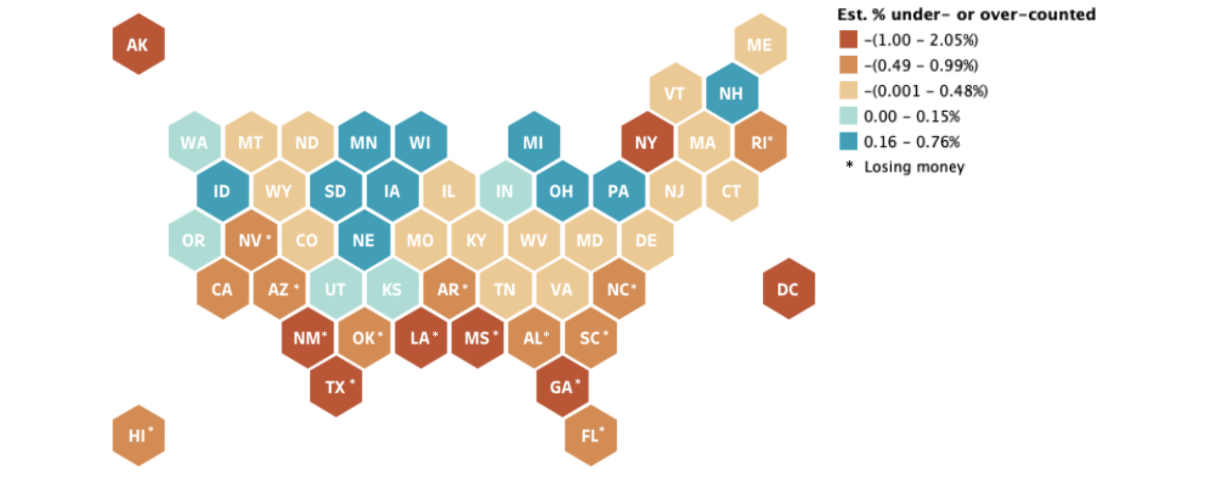Select a Data Category....
Explore Pandemic to Prosperity Data
Browse our data snapshots on topics like housing, jobs, health and more. View our full reports here.
Food Insecurity by state
In March 2022, 1 in 10 adults reported their household didn’t have enough to eat. Food insecurity was even more severe in MS, LA, AR, FL, and OK where 15% to 18% of adults reported not being able to put food on the table.
Difficulty Paying Expenses
The end of stimulus and child tax credits combined with inflation meant 34% of Americans had difficulty paying household expenses in March 2022, up from 26% in April 2021. Fully 37% of Southerners reported difficulty paying usual household expenses in the last 7 days, compared to only 33% of non-Southerners.
Employment Rates
As jobs increase, the employment rate has inched up to 60.1% but remained below its February 2020 level before the pandemic hit. The employment rate for Black adults was lowest at 58.3%. The employment rate for women inched up to 56.2% in March 2022, while the employment rate for men stayed at 68.1%.
Internet Access
Broadband internet access has become an essential utility for every American family. Yet, according to new data, 31% of Southern counties have poor internet access (25% or more of households lack internet) compared to 9% of non-Southern counties.
News Deserts
Local news sources are an essential platform for both transparency and community input in small communities, and many understand what is lost without them. The steady decline of local newsrooms since 2004 has accelerated since the beginning of the pandemic, with over 100 local newsrooms closing entirely since the start of 2020.
Medical Debt
Before Covid struck, 18% of Americans carried medical debt, with Southerners carrying the highest average medical debt amounts. States that expanded Medicaid by 2014 saw a greater decline in medical debt among their residents than did states that failed to expand Medicaid.
State Courts
State judiciaries constitute a critically important institution within American democracy, handling more than 90% of all cases in the United States. In 2021, legislators introduced more than 150 bills in 35 states that would weaken the power and independence of state courts, more than any year in recent decades.
Severe housing costs
The nation was facing a severe housing shortage when the pandemic struck in 2020. Following the Great Recession, new home construction dramatically declined — driving up home prices over the decade without commensurate increases in income.
New Voting Laws
Despite gains made in voter turnout in 2020, 19 states passed laws restricting voter access in 2021.
Student Loan Debt
The pause on student loan payments saved borrowers an average of $393 a month, an essential support as many struggled with unstable income over the course of the pandemic. Once student loan payments resume, it is estimated that roughly 18 million borrowers will lose $85.5 billion of their income annually.
Emergency Rental Assistance
The December 2020 stimulus bill and the March 2021 American Rescue Plan (ARP) include a combined $45 billion in Emergency Rental Assistance (ERA) funds, and a portion of these funds can be used for housing counseling and eviction diversion programs.
News Deserts
With rapidly-changing Covid information and guidance, ranging from safe return to in-person school protocols, to community testing, local news sources are an essential platform for both transparency and community input.
State Courts
In 2021, legislators introduced more than 150 bills in 35 states that would weaken the power and independence of state courts, more than any year in recent decades.
New Voting Laws
Since the 2020 election, there have been a series of voting laws passed in states across the nation. In 2021, 11 states enacted voting laws that only make it harder for Americans to vote. 17 states passed only expansive voting laws in 2021, and 8 states passed a combination of both expansive and restrictive voting laws.
Child Tax Credit Benefits
Several studies of the impact of the Child Tax Credit since its inception in 1998 have found that this financial support for children helped increase student test scores, reduce teen birth rates, and yield higher earnings in adulthood.
Emergency Rental Assistance
The December Stimulus bill (ERA) and the March American Rescue Plan (ERA2) include a combined $45 billion in rental assistance. But this assistance is being doled out through hundreds of state and local emergency rental assistance programs that vary greatly. Many places have been slow to distribute this critical aid.
American Community Survey Response Rates
Survey research and, most glaringly, political polls have become less reliable and predictive in recent years due to declining response rates, and the fact those who do respond may be different than those who do not.
Census Undercounts
Undercounts (and overcounts) affect state and federal political representation and funding for necessities such as infrastructure, children’s programs, and health care. Texas, for example, has one of the highest estimated undercounts, causing Texans to potentially lose out on over $247 million of Medicaid funding annually.
Missing Data
Consistent and complete data are crucial to full and equitable recovery from the pandemic. Yet states across the U.S. struggle to provide timely and dependable data nearly 2 years after its start. In some states, data reporting has slowed dramatically or even stopped completely.
Employment Rates
The nationwide employment rate of 58.7% is 2 percentage points lower than Feb 2020. Black and Hispanic workers have been hit particularly hard with employment rates down 3 to 4 percentage points. In September 2021, the employment rate for men inched up to 66.7%, while the employment rate for women was stagnant at 54.7%.



















